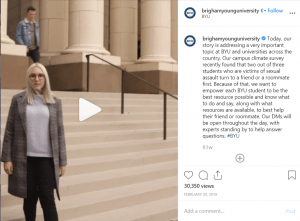Telling sensitive higher ed stories on Instagram
By Sharon Aschaiek | Sept. 11, 2019

It’s relatively easy for a higher education institution to share good news on social media, but how does a school handle sensitive or thorny subjects on these platforms, such as sexual violence, racism and mental illness? Brigham Young University in Utah and its media relations and social media manager, Jon McBride, chose to tackle some of these topics head on with an innovative Instagram campaign that engaged students and earned the respect of the higher ed sector.
The back story
First, some necessary background: in the spring of 2017, in response to sexual violence issues campus, BYU conducted a campus climate survey to assess sexual misconduct events, student perceptions of their safety on campus, and student awareness of resources and trainings. Among the compelling insights that emerged: most victims disclosed to friends or roommates; most don’t know where to direct a friend for help; and a quarter said training and prevention practices seemed lacking. In response, the university took significant steps to raise awareness about campus resources and strengthen its training programs.
Leveraging Instagram

This is where McBride and his team—two BYU students in social media roles—come in. Between February 2018 and March 2019, they published four Instagram stories on the following topics: helping a survivor of sexual assault; consent; respecting others; and helping distressed students. In this blog, we’ll take a close look at the first story—its goals, how it came together, and the response from the BYU community.
McBride’s immediate manager supported the idea, but to get buy-in from the university’s leaders, he went ahead and produced the entire story, and then presented it along with the hard data—the concept was approved. He says there was a consensus that the university should get in front of this problem.
“This was a really important thing we were trying to tell people,” says McBride, who presented on the stories as part of a broader workshop on optimizing Instagram for higher ed at eduWeb Digital Summit 2019. “We had data showing that students want to help, but they don’t know how. That data was critical to getting this project approved.”
High production values
While most Instagram stories the school posts are casual in format and brief in length, McBride knew this important topic deserved more: the piece features high production values and is five minutes and 45 seconds. The content focuses on key stats from the survey, and information on counselling and psychological services on campus, and how to support a friend or roommate who has experienced unwanted touching or been raped. Importantly, it also indicates that amnesty is granted for any honour code violations that occurred during the time of a sexual assault (students at BYU, which was founded and is guided by the Church of Jesus Christ of Latter-day Saints, agree to obey bans on activities such as alcohol consumption and premarital sex).
McBride and his team took a few months to get the script, filming and editing right, and recruited the school’s videographer to ensure high-quality results. Most of the messaging is delivered by BYU students in order to make the most impact. Instagram was identified as the right social platform because of its high popularity with youth.

Planning responses
A key part of this project involved planning ahead how to respond to comments and DMs generated by the video. For this process, which took another few months, McBride enlisted relevant experts on campus, including the director of the Title IX office, the survivor advocate and a psychologist, and together, they developed thoughtful, informed responses to various scenarios. These individuals agreed to be part of an on-call response team that conducted deep listening and responded to queries.
Significant resonance
The story attracted 24,000+ views in 24 hours—today, that number is over 30,000—hundreds of direct messages, including from those personally or indirectly affected by a crisis. As well, both the Title IX office and survivor advocate received an influx of reports and appointments in the days following the story’s posting. It has also attracted positive feedback and inquiries from other higher ed institutions interested in taking a similar approach.
“It was extremely gratifying to see that result and the impact we could make. It was way beyond what we expected,” McBride says. “We wanted to signal that we aren’t just offering a Band-Aid solution or PR response…We wanted to empower each person in our campus community to be a helper.”